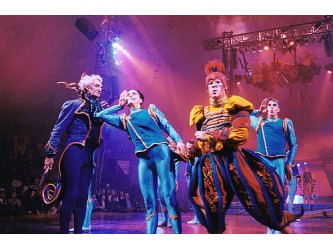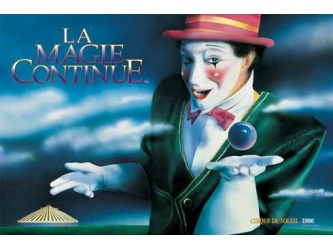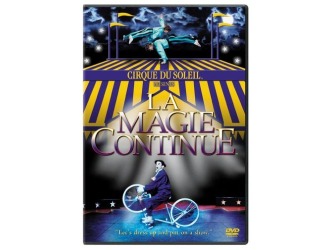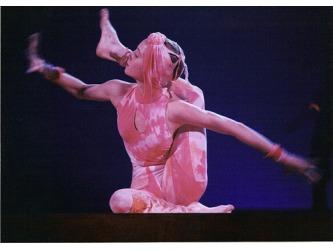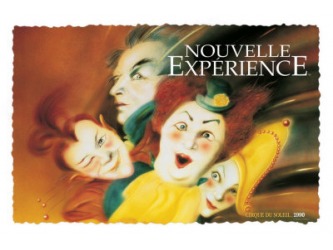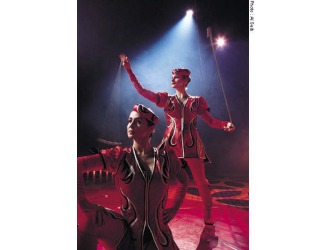**PAST SHOWS**
LE GRAND TOUR DU CIRQUE DU SOLEIL

Le Grand Tour Du Cirque Du Soleil
On stage at the 1994 finale of Nouvelle Expérience.
Originally intended to only be a one-year project, Cirque du Soleil was scheduled to perform in 11 towns in Quebec over the course of 13 weeks running concurrent with the third La Fête Foraine. The first shows were riddled with difficulty, starting with the collapse of the big top after the increased weight of rainwater cause the central mast to snap. Working with a borrowed tent, Laliberté then had to contend with difficulties with the European performers who were so unhappy with the Quebec circus' inexperience, that they had at one point sent a letter to the media complaining about how they were being treated.
The problems were only transient, however, and by the time 1984 had come to a close, Le Grand Tour du Cirque Du Soleil was a success. Having only $60,000 left in the bank, Laliberté went back to the Canadian government to secure funding for a second year. Unfortunately, while the Canadian federal government was enthusiastic, the Quebec provincial government was resistant to the idea. It was not until Quebec's Premier, René Lévesque, intervened on their behalf that the provincial government relented.
The original big top tent that was used during the 1984 Le Grand Tour du Cirque Du Soleil tour can now be seen at Carnivàle Lune Bleue, a 1930s-style carnival that is home to the Cirque Maroc acrobats.
Le Grand Tour du Cirque du Soleil
En el escenario de la final de 1994 Nouvelle Expérience.
Originalmente destinados a ser sólo un año de proyecto, del Cirque du Soleil estaba previsto llevar a cabo en 11 ciudades de Quebec en el curso de 13 semanas junto con la tercera de La Fiesta Foraine. La primera muestra se plagado de dificultades, empezando por el colapso de la carpa tras el aumento de peso del agua de lluvia causa el mástil hasta que encaje. Trabajar con una carpa prestada, Laliberté entonces tuvo que hacer frente a dificultades con la que los artistas intérpretes estaban tan descontentos con el Quebec circo 'inexperiencia, que tenían en un momento envió una carta a los medios de comunicación se quejan de la forma en que estaban siendo tratados.
Los problemas eran sólo transitoria, sin embargo, y en el momento en 1984 había llegado a su fin, Le Grand Tour du Cirque du Soleil fue un éxito. Que sólo 60.000 dólares en el banco, volvió a Laliberté el gobierno canadiense para obtener financiación para un segundo año. Lamentablemente, mientras que el gobierno federal canadiense se mostró entusiasmado, el gobierno provincial de Quebec fue resistente a la idea. No fue sino hasta el Premier de Québec, René Lévesque, intervenido en su nombre que el gobierno provincial cedió .
La original carpa que se utilizó durante el 1984 Le Grand Tour du Cirque Du Soleil recorrido se puede ver en Carnivàle Lune Bleue, un estilo de carnaval 1930 que es el hogar de los acróbatas del Cirque de Marruecos .
GALLERY
LA MAGIE CONTINUE

La Magie Continue The "grand chapiteau" set up in Montreal, Quebec Saint-Michel neighbourhood.
After securing funding from the Canadian government for a second year, Laliberté took steps to renovate Cirque from a group of street performers into a "proper circus". To accomplish this he hired the head of the National Circus School, Guy Caron, as Cirque Du Soleil's artistic director. The influences that Laliberté and Caron had in reshaping their circus were extensive. They wanted strong emotional music that was played from beginning to end by musicians. They wanted to emulate the Moscow Circus' method of having the acts tell a story. Performers, rather than a technical crew, move equipment and props on and off stage so that it did not disrupt the momentum of the "storyline". Most importantly, their vision was to create a circus with neither a ring nor animals. The rationale was that the lack of both of these things draws the audience more into the performance.
To help design the next major show, Laliberté and Caron hired Franco Dragone, another instructor from the National Circus School who had been working in Belgium. When he joined the troupe in 1985, he brought with him his experience in commedia dell'arte techniques, which he imparted on the performers. Although his experience would be limited in the next show due to budget restraints, he would go on to direct every show up to, but not including Dralion.
By 1986, the company was once again in serious financial trouble. During 1985 they had taken the show outside Quebec to a lukewarm response. In Toronto they performed in front of a 25% capacity crowd after not having enough money to properly market the show. Gilles Ste-Croix, dressed in a monkey suit, walked through downtown Toronto as a desperate publicity stunt. A later stop in Niagara Falls turned out to be equally problematic. Despite critical praise, both shows were a failure that put Cirque du Soleil $750,000 in debt.
Several factors prevented Cirque from going bankrupt that year. The Desjardins Group, which was Cirque du Soleil's financial institution at the time, covered about $200,000 of bad checks. Also, a financier named Daniel Lamarre, who worked for one of the largest public relations firms in Quebec, represented the company for free, knowing that they didn't have the money to pay his fee. The Quebec government itself also came through again, granting Laliberté enough money to stay solvent for another year.
[ edit ] La Magie ContinueLa Magia Continúa
The "grand chapiteau" set up in Montreal , Quebec Saint-Michel neighbourhood. La "gran Carpa", creado en Montreal,Quebec, barrio de Saint-Michel.
After securing funding from the Canadian governmentfor a second year, Laliberté took steps to renovate Cirque from a group of street performers into a "proper circus". Después de asegurar la financiación del gobierno canadiense para un segundo año, tomó medidas para Laliberté renovar Cirque de un grupo de artistas callejeros en un "circo". To accomplish this he hired the head of the National Circus School , Guy Caron, as Cirque Du Soleil's artistic director . Para lograr esto contrató a la cabeza de la Escuela Nacional de Circo Guy Caron, como el Cirque Du Soleil del director artístico.The influences that Laliberté and Caron had in reshaping their circus were extensive. Las influencias que Laliberté y Caron había en la reestructuración de su circo se amplia. They wanted strong emotional music that was played from beginning to end by musicians. Querían emocional fuerte la música que se jugó de principio a fin por los músicos. They wanted to emulate the Moscow Circus' method of having the acts tell a story. Que querían emular el Circo de Moscú "con el método de actos contar una historia. Performers, rather than a technical crew, move equipment and props on and off stage so that it did not disrupt the momentum of the "storyline". Artistas Intérpretes o Ejecutantes, en lugar de un equipo técnico, equipo y mover objetos en y fuera del escenario de manera que no perturben el impulso de la "historia". Most importantly, their vision was to create a circus with neither a ring nor animals. Lo que es más importante, su visión era crear un circo con un anillo, ni tampoco animales. The rationale was that the lack of both of these things draws the audience more into the performance. [ 16 ][ 4 ]La razón fue que la falta de ambas cosas a la audiencia se basa más en el rendimiento.
To help design the next major show, Laliberté and Caron hired Franco Dragone , another instructor from the National Circus School who had been working in Belgium . Para ayudar a diseñar el próximo gran espectáculo, Laliberté y Caron contratado Franco Dragone, otro instructor de la Escuela Nacional de Circo, que ha estado trabajando en Bélgica.When he joined the troupe in 1985, he brought with him his experience in commedia dell'arte techniques, which he imparted on the performers. Cuando se incorporó a la compañía en 1985, trajo con él su experiencia en la commedia dell'arte técnicas, que se imparte en los artistas intérpretes o ejecutantes. Although his experience would be limited in the next show due to budget restraints, he would go on to direct every show up to, but not including Dralion . [ 4 ]Aunque su experiencia se limita en el próximo show, debido a las restricciones de presupuesto, que iría en directo a todos los que aparecen, pero sin incluir el Dralion
By 1986, the company was once again in serious financial trouble. En 1986, la compañía fue una vez más en graves problemas financieros. During 1985 they had taken the show outside Quebec to a lukewarm response. En 1985 se había tomado la muestra fuera de Quebec a una respuesta tibia. In Toronto they performed in front of a 25% capacity crowd after not having enough money to properly market the show. En Toronto se realizó frente a un 25% de su capacidad de multitudes después de no tener el suficiente dinero para mostrar correctamente el mercado. Gilles Ste-Croix, dressed in a monkey suit, walked through downtown Toronto as a desperate publicity stunt. Gilles Ste-Croix, vestido con un traje de mono, caminaron por el centro de Toronto, como un desesperado ardid publicitario. A later stop in Niagara Falls turned out to be equally problematic. Una última parada en las Cataratas del Niágara resultó ser igualmente problemático. Despite critical praise, both shows were a failure that put Cirque du Soleil $750,000 in debt. [ 4 ][ 17 ]A pesar de alabanza crítica, se muestra como un fracaso puesto que el Cirque du Soleil 750.000 dólares en deuda.
Several factors prevented Cirque from going bankrupt that year. Varios factores impidieron Cirque de quiebra de ese año. The Desjardins Group , which was Cirque du Soleil's financial institution at the time, covered about $200,000 of bad checks. El Movimiento Desjardins, que fue el Cirque du Soleil de la institución financiera en el momento, alrededor de $ 200.000 cubiertos de cheques. Also, a financier named Daniel Lamarre , who worked for one of the largest public relations firms in Quebec, represented the company for free, knowing that they didn't have the money to pay his fee. Asimismo, un financista llamado Daniel Lamarre, que trabajaba para una de las mayores empresas de relaciones públicas en Quebec, representado por la empresa libre, a sabiendas de que no tenían el dinero para pagar sus honorarios. The Quebec government itself also came through again, granting Laliberté enough money to stay solvent for another year. [ 4 ]El gobierno de Quebec también a través de sí mismo de nuevo, la concesión de suficiente dinero para Laliberté disolvente para permanecer un año más
GALLERY
LE CIRQUE RÉINVENTÉ
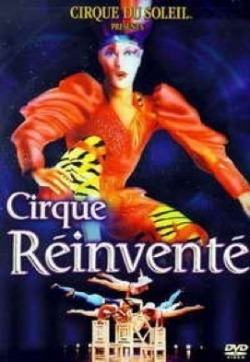
We Reinvent the Circus
In 1987, after Laliberté re-privatized Cirque du Soleil, it was invited to perform at the Los Angeles Arts Festival. Although they continued to be plagued by financial difficulties, Normand Latourelle took the gamble and went to Los Angeles, despite only having enough money to make a one-way trip. Had the show been a failure, Cirque would not have had enough money to get their performers and equipment back to Montreal.
The festival turned out to be a huge success, both critically and financially. The show attracted the attention of entertainment executives, including Columbia Pictures, which met with Laliberté and Gauthier under the pretense of wanting to make a movie about Cirque du Soleil. Laliberté was unhappy with the deal, claiming that it gave too many rights to Columbia, which was only attempting to secure all rights to the production. Laliberté pulled out of the deal before it could be concluded, and that experience stands out as a key reason why Cirque du Soleil remains independent and privately owned today.
In 1988, Guy Caron left the company due to artistic differences over what to do with the money generated by Cirque du Soleil's first financially successful tour. Laliberté wanted to use it to expand and start a second show while Caron wanted the money to be saved, with a portion going back to the National Circus School. An agreement was never met and Caron, along with a large number of artists loyal to him, departed. This stalled plans that year to start a new touring show.
Laliberté sought out Gilles Ste-Croix as replacement for the artistic director position. Ste-Croix, who had been away from Cirque since 1985, agreed to return. The company went through more internal troubles, including a failed attempt to add Normand Latourelle as a third man to the partnership. This triumvirate lasted only six months before internal disagreements prompted Gauthier and Laliberté to buy out Latourelle. By the end of 1989, Cirque du Soleil was once again in a deficit.
EL CIRCO REINVENTADO
En 1987, después de volver a Laliberté privatizadas Cirque du Soleil, que fue invitado a actuar en el Los Angeles Festival de las Artes. A pesar de que sigue estando plagado de dificultades financieras, Normand Latourelle tomó la apuesta y se fue a Los Ángeles, a pesar de tener suficiente dinero para hacer un viaje de ida. El espectáculo ha sido un fracaso, el Cirque no habría tenido suficiente dinero para obtener sus artistas intérpretes o ejecutantes y los equipos de vuelta a Montreal
El festival resultó ser un enorme éxito, tanto crítico y financiero. El espectáculo atrajo la atención de los ejecutivos de entretenimiento, incluidas Columbia Pictures, que se reunió con Laliberté Gauthier y bajo la pretensión de querer hacer una película sobre el Cirque du Soleil. Laliberté estaba satisfecho con el acuerdo, alegando que dio demasiados derechos a Columbia, que fue sólo tratar de conseguir todos los derechos a la producción.Laliberté se retiraron de la operación antes de que pueda concluirse, y que la experiencia se destaca como un importante motivo por el Cirque du Soleil sigue siendo independiente y de propiedad privada, hoy en día.
En 1988, Guy Caron izquierda de la empresa debido a diferencias artísticas sobre qué hacer con el dinero generado por el Cirque du Soleil, la primera financieramente exitosa gira.Laliberté quería utilizarla para ampliar y empezar a mostrar un segundo, mientras que Caron quería el dinero para ser salvado, con una porción que se remonta a la escuela Nacional de Circo. Un acuerdo nunca fue cumplido y Caron, junto con un gran número de artistas fieles a él, salió. Este estancamiento de los planes de ese año para iniciar una nueva gira por demostrar .
Laliberté buscado Gilles Ste-Croix en sustitución de la posición de director artístico. Ste-Croix, que había sido fuera de Cirque desde 1985, de acuerdo a regresar. La empresa pasó por más problemas internos, incluyendo un intento fallido para añadir Normand Latourelle como un tercer hombre a la asociación. Este triunvirato duró sólo seis meses antes de desacuerdos internos impulsó Gauthier y Laliberté a comprar Latourelle. A finales de 1989, Cirque du Soleil fue, una vez más, en un déficit.
gallery
NOUVELLE EXPÉRIENCE
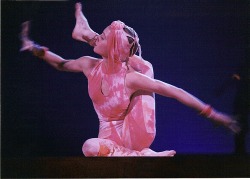
NOUVELLE EXPÉRIENCE
An acrobat performs in the contortion act of Nouvelle Expérience.
In that same year, Cirque attempted to revive one of its previous shows, Le Cirque Réinventé. The attempt was abandoned after a weak critical reception. Laliberté and Ste-Croix instead created a new show based on the plans that had originally been drawn up by Caron before his departure. Originally intended to be called Eclipse, they renamed the show Nouvelle ExpérienceFranco Dragone agreed to return—albeit reluctantly—but only if he had full creative control of the show's environment. One of the first things he did was to remove the curtain that separated the artist from the audience, so that they would both feel part of a larger show.
Whereas in a traditional circus the artist could go past the curtain and drop his role, Dragone had created an environment where the artist had to remain in character for the full length of the production. Although Dragone was given full control over the show, Laliberté oversaw the entire production. He was in favor of Dragone's new ideas. Inspired by Jules Verne's "La Chasse au Météore", Dragone's concept for the show was that each of the performers were playing the parts of jewels spread around the EarthNouvelle Expérience turned out to be Cirque du Soleil's most popular show up to that point and would continue running until 1993. It spent one of those years at The Mirage Resort and Hotel on the Las Vegas Strip. By the end of 1990, Cirque was profitable again and was prepared to start a new show.Nouvelle Expérience was Cirque du Soleil's 4th creation, which begun staging in 1990. The show's tour ended in 1993 in the Mirage Parking lot in Las Vegas, Nevada.
Acts and Description
Contortion Four women, clad in pink, take to a suspended platform amidst the stage. They appear to not know where they are, as their faces express curiosity. The beat of their music strikes movement in their bodies, and soon the four twist and bend themselves into unbelievable positions!(Performed to "Meandres" on the Soundtrack)
Korean Plank As the contortion gives way, Madame and the Corporation approach a see-saw-like object in the middle of the stage. They begin to jump on the ends, bouncing the opposite performer into the air. Soon, they begin performing twists and spins, and even form towers by flipping acrobats onto other acrobat's shoulders!(Performed to "Bascule" on the soundtrack)
Solo Trapeze When the Korean Plank act leaves the stage, an odd introduction happens between one of the Flounes, and the Everyman. Afterwards, a woman takes to the stage, and is lifted towards a trapeze. She begins a beautiful number above, while flounes and devils watch from below. (Performed to "Fixe", "Ballant", and "Baleines" on the soundtrack)
Fil de Fer As the woman exits the stage, one of the flounes moves about on a wooden ball. He spins, dances, and jumps until the Everyman enters the stage. At this point, the Everyman and the Floune try to shake hands again, but this attempt is successful. They begin to dance until the four other flounes enter near backstage. They take the fifth floune's ball, do a little trick with a quilt, and it turns into a tightroper! The man soon jumps up onto his tightrope (which is only five or so feet high)and begins to perform many tricks. Soon, the ringmaster gives it a try and fails miserably. The two switch off, and the ringmaster gets better and better until the two are performing together!Fanfare A little parade organized by Madame Corporation introduces the next act...(Performed to "Fanfare" on the soundtrack)
Aerial Straps A rather muscular man enters the stage, and approaches two leather straps hanging from the ceiling. He takes to the straps, and takes flight! He spins, flips, and hangs to a beautiful cello piece entitled "L'oiseau".Trapeze As the second act begins, six figures appear, and climb three rope ladders up to a flying trapeze. But no, this is not a usual one. There is one regular trapeze, a two-layered trapeze, and a Russian Trapeze. They swing back and forth between the three, whilst performing rather daring tricks. Soon, the act ends, and the six take their final bows.(Performed to "Azimut" and "Sanza" on the soundtrack)
Foot Juggling As the Trapeze is taken down, two beautiful oriental women take to the stage. First, one begins to spin umbrellas on her feet and hands. Soon, she's juggling the other girl, and the other girl's spinning cloths on her feet!(Performed to "Suite Chinoise" on the soundtrack)
Russian Bars/Trampoline/Korean Cradle Three acts combined into one work out beautifully! Russian Bars- A 5-inch wide bar held by two men across their shoulders, while a third bounces on it. Trampoline- You should know what this is. Korean Cradle. Two men are strapped in on platforms, and take women by their hands to swing and flip them between one another. (All performed to "Eclipsé" on the Soundtrack)
Balancing on Chairs A man dressed in white takes to the stage, a few chairs in his hands. He begins to stack and the chairs, and balance on them, along with a flaming birthday cake!(Performed to "Havi Vahila" on the Soundtrack)
Closing
Characters
Flounes - The Fallen angels. Dressed in browns and ochres.
Devils - The spirits of disobedience.
Dressed in redsCorporation - The Slaves of the world.
Dressed in BlueMadame Corporation - Queen of the Flounes, and along with the Great Chamberlain, ruler of the Corporation.
Great Chamberlain (aka Ringmaster) - Madame Corporation's Right-hand man.
Everyman - Dressed in a brown suit, he represents all of us.
Soundtrack
1. Fanfare
2. Meandres
3. Bolero
4. Bascule
5. Fixe
6. Ballant
7. Baleines
8. Havi Vahila
9. Suite Chinoise
10. Eclipse
11. L'oiseau
12. Azimut
13. Sanza
14. Grosse Femme
NOUVELLE EXPÉRIENCE
Un acróbata realiza en el acto de contorsión Nouvelle Expérience.
En ese mismo año, el Cirque intentado revivir uno de sus anteriores espectáculos, Le Cirque Réinventé.Originalmente destinados a ser llamado Eclipse, que muestran el nombre de Nouvelle Expérience
Franco Dragone acordó volver-aunque sea a regañadientes-pero sólo si tenía pleno control creativo del espectáculo de medio ambiente.Considerando que, en un circo tradicional el artista podría ir más allá de la cortina y la caída de su papel, Dragone ha creado un entorno en el que el artista tuvo que permanecer en carácter de la longitud completa de la producción .
Aunque Dragone fue dado el control total de la muestra, Laliberté supervisó la totalidad de la producción.Inspirada por Jules Verne "LaChasse au Météore", Dragone el concepto para el show fue que cada uno de los artistas intérpretes o ejecutantes eran las piezas de juego de joyas repartidas alrededor de la Tierra
Nouvelle Expérience resultó ser Cirque du Soleil más populares muestran hasta que punto, y seguirá funcionando hasta 1993. Se gasta uno de esos años en el The Mirage Resort and Hotel en Las Vegas Strip.A finales de 1990, el Cirque fue rentable y está dispuesta a iniciar un nuevo espectáculo
Nouvelle Expérience fue el Cirque du Soleil's 4 de la creación, que comenzó en escena en 1990. El espectáculo de la gira terminó en 1993 en el Parking Miracle en Las Vegas, Nevada.
Hechos y descripciones
Contorsión
Cuatro mujeres, vestidos de color rosado, para tener una plataforma suspendida en medio de la etapa Ellos parecen no saber dónde están, como sus rostros expresan la curiosidad. El ritmo de su música en movimiento de huelgas de sus cuerpos, y pronto los cuatro y doble giro increíble en sí mismas posiciones! (Realizadas a "Meandres" en la banda sonora)
Corea Plank
Dado que la contorsión da paso, y la Corporación de Madame un enfoque ver-vi-objeto como en el centro de la escena. Empiezan a saltar en los extremos, rebotando el artista frente a la atmósfera. Pronto, comienzan la realización de giros y giros, e incluso la forma de torres volteando acróbatas en otros acrobat hombros! (Realizadas a "basculante" en la banda sonora)
Solo Trapecio Cuando el coreano Plank acto deja el escenario, una introducción extraño sucede entre una de las Flounes, y el Everyman. Después, una mujer lleva a la escena, y se levanta a un trapecio. Ella comienza un hermoso número anterior, además de flounes y demonios ver desde abajo. (Realizado a "Fixe", "Ballant", y "Baleines" en la banda sonora)
Fil de Fer
Como la mujer sale de la etapa, uno de los flounes se mueve sobre una bola de madera. Él giros, bailes, saltos y hasta el Everyman entra en la etapa. En este punto, el Everyman y el Floune tratar de estrechar la mano de nuevo, pero este intento tiene éxito. Ellos comienzan a bailar hasta que los otros cuatro flounes cerca de entrar en los bastidores. Ellos toman el quinto floune la bola, hacer un pequeño truco con un edredón, y se convierte en una tightroper! El hombre pronto salta a la cuerda floja (que está a tan sólo cinco o más metros de altitud) y comience a realizar muchos trucos. Pronto, el jefe de pista le da una oportunidad y no miserablemente. Los dos apague, y el jefe de pista es mejor y mejor hasta que los dos están realizando juntos!
Fanfarria
Un poco desfile organizado por la Corporación de Madame introduce el siguiente acto ... (realizadas a "Fanfare" en la banda sonora)
Correas aéreas
A Un hombre entra muscular y no el escenario, y dos enfoques de cuero colgando del techo. Que adopte para dar a las correas, y emprende el vuelo! Él giros, flips, y cuelga una hermosa pieza de violonchelo titulada "L'oiseau".
Trapecio
En el segundo acto comienza, de seis cifras, y subir tres cuerda hasta un trapecio volador. Pero no, esto no es un habitual. Hay un trapecio regular, un trapecio de dos capas, y un ruso Trapecio. Ellos columpio hacia adelante y hacia atrás entre los tres, mientras que la realización de los trucos más atrevidos. Pronto, el acto termina, y los seis tomar sus arcos final. (Realizadas a "Azimut" y "Sanza" en la banda sonora)
Pie de Malabarismo
Como el Trapecio es bajado, dos hermosas mujeres orientales a tomar el escenario. En primer lugar, comienza a girar un paraguas de sus pies y manos. Pronto, ella es la otra chica haciendo malabarismos, y la otra niña hilando telas en sus pies! (Realizado a la "Suite Chinoise" en la banda sonora)
Barras Rusas / Trampolín / Cuna Coreana
Tres actos en una labor combinada de bonito! Bares ruso-A 5-pulgada de ancho de barras en manos de dos hombres a través de sus hombros, mientras que un tercero rebota en ella. Trampolín-Usted debe saber lo que es esto. Cuna coreano. Dos hombres están atados en el plataformas, y las mujeres por sus manos y la tapa a oscilar entre ellos uno del otro. (Todos los realizados a "Eclipse" en la banda sonora)
Equilibrio sobre sillas
Un hombre vestido de blanco se hace a la etapa, a pocos presidentes en sus manos. Comienza a la pila y sillas, y el equilibrio de ellos, junto con una llama de torta de cumpleaños! (Realizadas a "Havi Vahila" en la banda sonora)
Clausura
PERSONAJES
Flounes - los ángeles caídos. Dressed in browns and ochres. Vestida de marrones y ocres.
Demonios - los espíritus de la desobediencia. Dressed in reds Vestida de rojo
Corporation - Los esclavos del mundo. Dressed in Blue Vestida de azul
Madame Corporation - Reina de los Flounes, y junto con el Gran Chambelán, gobernante de la Corporación.
Gran Chamberlain (alias efrain) - Madame Corporation mano derecha.
Everyman - Vestida con un traje marrón, representa a todos nosotros.
Soundtrack
1. Fanfare Fanfarria
2. Meandres
3. Bolero
4. Bascule Basculante
5. Fixe
6. Ballant
7. Baleines
8. Havi Vahila Havi Vahila
9. Suite Chinoise Suite Chinoise
10. Eclipse
11. L'oiseau
12. Azimut
13. Sanza
14. Grosse Femme Grosse Femme
